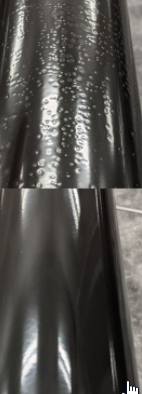Mitigating Fish Eye Defects
Having trouble with fish eye defects in your powder coating? Verney Denerville of Tiger Drylac offers insights for avoiding and fixing this common coating defect.

Fish eye defects are categorized by a deep, circular void in the coating film that reaches the substrate.
Photo Credit: TIGER Drylac
Q: We are having trouble with fish eye defects. How can we fix the problem and keep it from reoccurring?
As with other coating defects, fish eyes in powder coating are most often the result of contamination in your product’s surface. Contamination can also cause the powder to flake or peel. Common sources of contamination include silicone, oil or water.
Fish eye defects are categorized by a deep circular void in the coating film that reaches the substrate. Fish eyes can vary in size. The defects are most often caused by wax, grease or another oily substance that was improperly cleaned from the surface. Other causes can include:
- Contamination from the air compressor
- Contamination from the indoor environment
- Contamination on the surface, such as silicone
Contamination often originates from the manufacturing of the part. If a defect is from contaminated coating material or manufacturing byproducts that have not been removed by the cleaning process, it is likely to be evenly distributed. If the defect is caused by an external source, it will more likely be random. Examples of contamination from external sources can include things as subtle as hairspray or antiperspirant from the person spraying the part.

Before (top) and after (bottom) repairing a fish eye defect.
Photo Credit: TIGER Drylac
Fixing fish eyes
If you do end up having a fish eye defect, you’ll need to recoat the part. Here are some things you will need to do in order to properly fix the defect:
- Sand to a smooth finish and thoroughly clean the surface
- Complete a white rag test to ensure the surface is clean
- Determine the source of the defect before recoating
Preventing fish eyes
Of course, a better scenario is preventing the fish eye defect from occurring in the first place. Let’s discuss some things you can do to prevent the problem.
A white rag test can be instrumental in the prevention of fish eye defects. Once the part has completed the pretreatment rinse, simply take a white rag and run it over the part. Ideally, the rag should come up clean. It is also important to check your air lines in order to make sure they are clear of any contaminants.
As you work to find the cause of any defect, you must isolate each variable to make sure you can, in fact, determine the actual cause of the defect and eliminate the problem at its source.
Remember, to avoid fish eyes, prevention is important. Make sure the surface is prepared, equipment is clean and there is no dirt, grime or loose particles. Finally, we should discuss what to do if you are refinishing a part. When powder coating over a surface that had paint on it previously, you’ll want to verify prior to coating that the surface has no contaminants on it and that the previous paint has no contaminants embedded in it.
About the Author
Verney Denerville
Verney Denerville is an application field specialist, for TIGER Drylac. Visit tiger-coatings.com.
Related Content
Surface Prep Solution for Rusted Rebar in Concrete
Julie Holmquist of Cortec Corporation discusses passivating corrosion on rebar and other reinforcing metals.
Read MoreTroubleshooting Alkaline Zinc
One of the most common problems that can arise when plating with alkaline zinc is an imbalance of brightener in the solution. In this helpful Ask the Expert article, Chad Murphy of Columbia Chemical discusses how different zinc metal concentrations and brightener concentrations can impact efficiency.
Read More10 Anodizing Best Practices
Following this list of guidelines can help to increase the performance, cost effectiveness and quality for your anodizing operation.
Read MoreHow to Choose Between Sulfate and Chloride-Based Trivalent Chromium
There are several factors to consider when choosing between sulfate and chloride-based baths for trivalent chromium plating. Mark Schario of Columbia Chemical discusses the differences and what platers should keep in mind when evaluating options.
Read MoreRead Next
Education Bringing Cleaning to Machining
Debuting new speakers and cleaning technology content during this half-day workshop co-located with IMTS 2024.
Read MoreDelivering Increased Benefits to Greenhouse Films
Baystar's Borstar technology is helping customers deliver better, more reliable production methods to greenhouse agriculture.
Read MoreA ‘Clean’ Agenda Offers Unique Presentations in Chicago
The 2024 Parts Cleaning Conference, co-located with the International Manufacturing Technology Show, includes presentations by several speakers who are new to the conference and topics that have not been covered in past editions of this event.
Read More






















